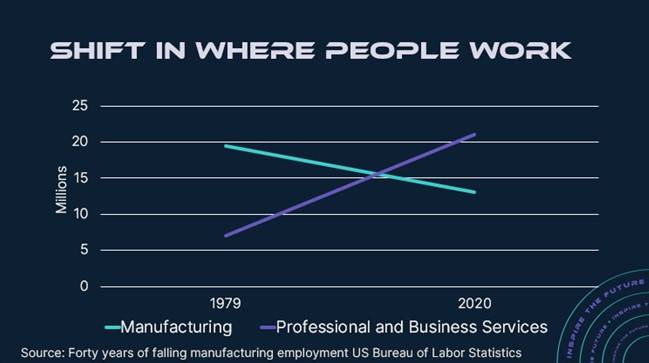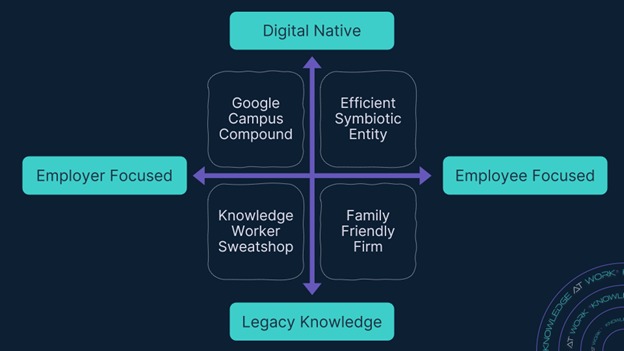Knowledge at Work - Episode 1
Innovations in Professional Service
In this episode, we’ll explore the journey that brought us to this point and preview what to expect in future episodes.
Spotify
Coming soon
Amazon
Coming soon
Knowledge work is changing the world. More people are earning a living through mental effort than physical effort and with that comes unique challenges. In 1979 the US economy saw 19,500,000 workers in manufacturing vs 7,000,000 in professional and business services. In 2020 those numbers were 13,000,000 workers in manufacturing vs 21,000,000 in professional and business services.

In manufacturing we typically see a division between physical labor and mental management. Sure, some labor involved mental skills and some management do physical work, but for the most part the split is easy to recognize. Knowledge work greatly changes this dynamic. Labor is asked to do more traditional management tasks and management is tasked with more actual production. The core problem is that management continues to lean heavily on the techniques developed during the industrial revolution.
The goal of this series is to think about how the relationship between three groups can evolve to better meet the needs of the future. Those three groups are:
Talent
The people doing the technical mentally challenging tasks.
Management
The people responsible for getting the most out of the talent.
Organization
The entity that provides tools and guidance to help both workers and managers create value.
As I mentioned earlier, talent and management are more comingled than ever before. People serving in these roles often switching between back and forth on a regular basis.
There are great opportunities for organizations, if they can rethink how they operate. Today there is a great variety of organizations in the marketplace. We will divide them into two groups:
Legacy Knowledge Organizations
Created during the industrial revolution; they tend to be built around people using technology to deliver value.
Digital Native Organizations
Created in the digital world; they tend to be built around people creating technology that then delivers value.
These are general terms and organizations live on a spectrum between the two. Neither is inherently better, but there are advantages built into each.
Another factor I would like to highlight is the focus of the organization.
Many organizations are very focused on the organization itself. Rules and processes are put in place to ensure the organization is protected. This is important, we need to make sure our organizations are not put at risk and that we follow appropriate rules and regulations.
The question comes when we go past the required compliance and move towards micro-management.
Just as a complete focus on the organization is not good, neither is an organization where the employees are given no guidance or structure.
As we talk about this, I would ask you to consider options that include employees in decision processes and that recognize there is a delicate balance to be discovered and that balance can ebb and flow over time.
Pulling these two spectrums together, we have created a matrix. It is highly unlikely that any organization is at the extreme on either, you can imagine the traditional bell curve at play on both with small numbers on the ends and the vast majority living in the middle.

Google Campus Compounds
These are organizations where technology is used but their people are not a priority. Many of these organizations create campuses where every life necessity is provided but this is done primarily to trap employees so they will work more.
Knowledge Worker Sweatshops
These are organizations where talent is treated like a machine. Constant pressure to produce combined with minimal tools to make that production easier.
Family Friendly Firm
These organizations treat their employees well, but have business tools and processes that do not align with how humans best operate.
Efficient Symbiotic Entity
These organizations treat their employees well and provide them the tools to perform at their best.
A key point I would like to highlight is the matrix on the prior slide has nothing to do with success or profitability. You can make a bunch of money anywhere on the matrix. There are also people who will thrive in different areas of the matrix.
What I would like you to consider is by combining modern methods and being more human centric, there are opportunities to do more with less and create an environment that people want to be a part of.
As we start this journey, I ask you to be open to the uncomfortable. Regardless of where you are in your organization, you can make a difference. Our world is rapidly changing and if we stay stuck in our ways, we will not be able to evolve.
Change isn’t easy for anybody. As we evolve make sure to understand and appreciate the work it takes from all of us, talent, management and organizations to evolve. The process will be a give and take and some of the concepts will not be a fit for everybody. The key is finding the right balance for you and your organization.
Before we wrap up today I want to touch on a couple of points that I don’t want to scare you away.
We are using the accounting firm as our sample organization. This doesn’t mean these concepts do not apply to your organization simply because it is not an accounting firm or on the size of your firm. If you are a sole practitioner you are constantly shifting between being the talent, the management, and the organization. Finding tools to help you balance these is very important.
Alternatively, if you work as a service center to a larger organization these concepts could apply at the team level.
The other thing I want to highlight early on is we will be talking about concepts that directly contradict themselves. As I said earlier we do not know the right answer, in large part because there is no one right answer. I encourage you to try different things and work on finding what works best for you, then keep doing that process to continue to evolve as things change over time.
This series will reference a variety of resources. You are encouraged to read or listen to these to learn more. As additional research is published, this series will expand. We are entering an unknown, there is no one right answer. I encourage you to adapt these concepts to your situation, then evaluate how things work and do not fear failure or iteration. Also remember that talent, management, and organizations co-exist. The best results will come from collaboration between these groups.
This is a challenge we are likely to be working on for the rest of our lives. It is a marathon not a sprint. To get the best results we need to respect the roles that talent, management, and organizations play. As you start on the journey know that there is no right way and it is important to learn from failure and success. Communication is key both within your organization and with others. We welcome your feedback and submissions for the future.
%2012.18.png)
